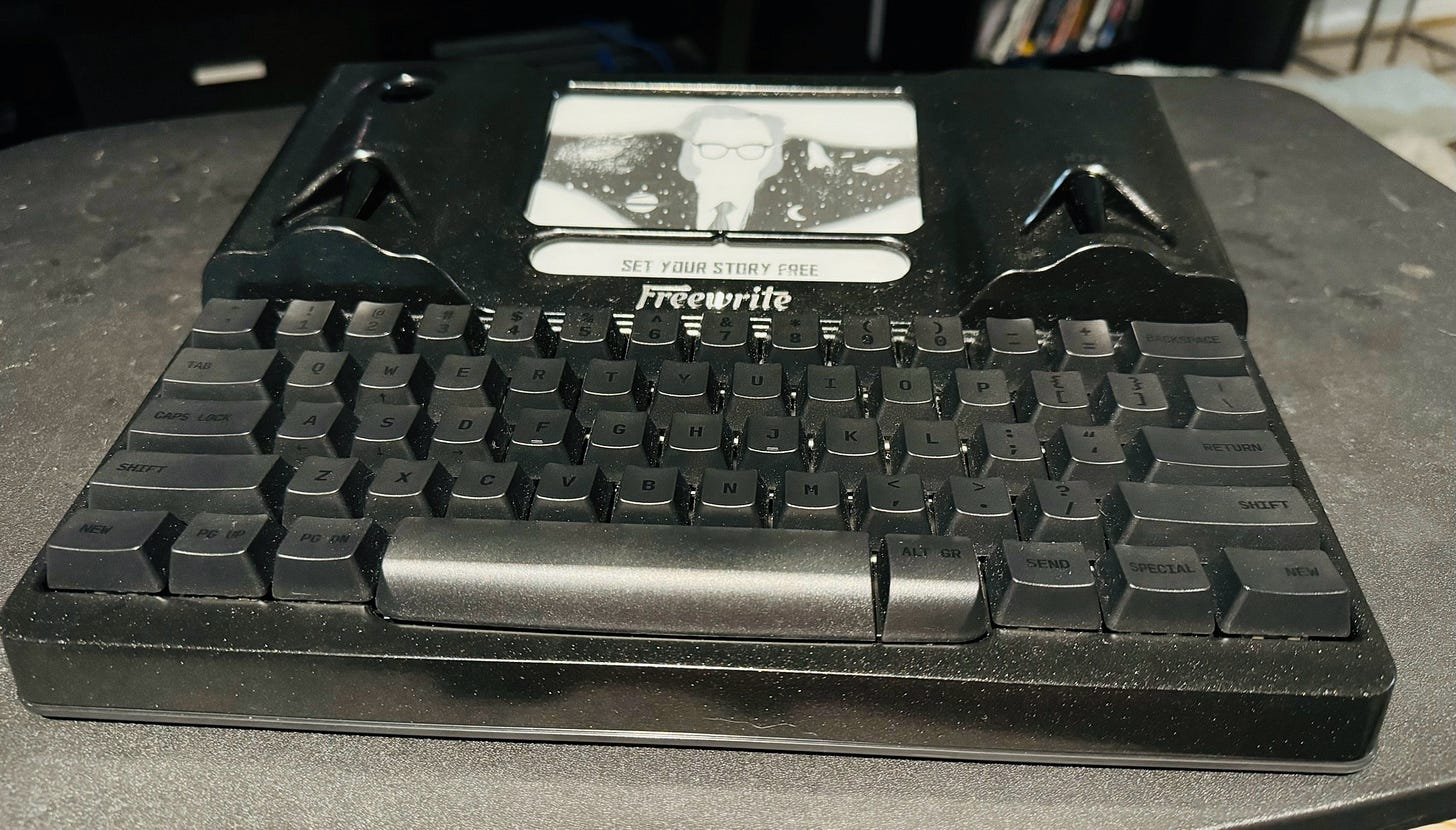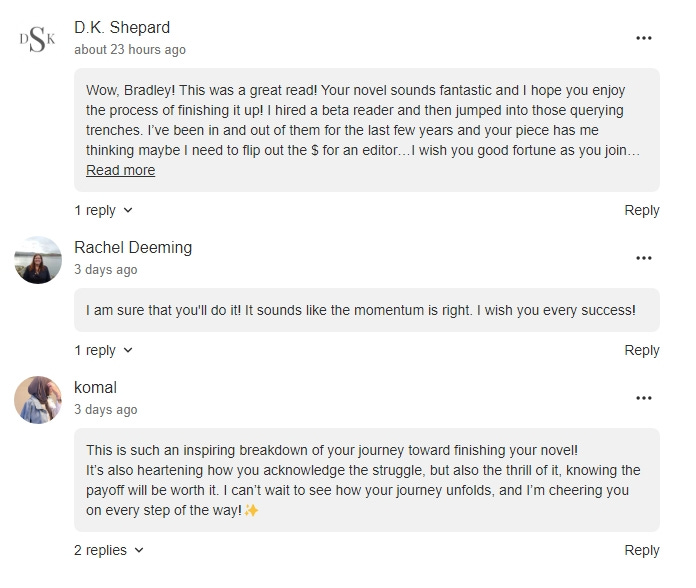If the picture of the Blue Tang above looks familiar, it’s because I’m referencing a certain animated fish that once told us all to “keep swimming.” It’s a familiar piece of advice, much like the old adage “if you’re going through hell, keep going.”
Quick show of hands: how many of you are under a lot of stress on a daily basis? As I expected, roughly 8 billion hands, give or take. Life is stressful, and that stress can easily drain our motivation to work on our novel, finish our screenplay, record our podcast, or whatever your project entails. What’s a writer to do?
I’m so very glad you asked.
Fighting Stress with Stories
This year, my personal motto is “Fight Stress with Stories.” As someone who often let’s all of my creative projects fall to the wayside when life gets hard, many of my 2024 goals have now become 2025 goals (I like to say that my 2025 writing goals are sequels to last year’s goals, but with edgy subtitles).
I find it extra difficult to consistently work on my creative projects, mostly because my full-time day job also involves a lot of writing. When you spend 8 hours or more a day writing, the prospect of doing even more writing doesn’t always sound very appealing.
I realize that’s not the case for everyone, but in general, many of us struggle to find motivation to pursue our creative projects when life is constantly beating us down.
We’re just over a week into 2025, and I’ve managed to write for myself every single day (including over the weekend), so I’ve decided that my second piece here on Substack should be geared towards helping my fellow writers find that inspiration, that energy, and that motivation that stress so eagerly devours in many of our lives.
So, without further delay, here are my steps to transform yourself into a consistent, resilient, and productive writer in the coming year:
Step One: Separate Yourself from the Stress
Prior to the COVID-19 pandemic, working from home wasn’t incredibly common. I myself have been working from one home office or another for over a decade now, but for many, remote work wasn’t an option until recently.
Whether you work in a home office, commute to the office, or you’re a hybrid employee that does a combination of the two, it’s incredibly important that you separate yourself (both physically and mentally) from the stresses of daily life.
If you spend eight hours a day in a spare bedroom, don’t use that room for writing your personal projects! I made this mistake for years, and more often than not, I found myself drained and burned out before I had written anything.
Sure, I was writing stories or scripts, but it still felt like work. They say you can’t heal in the place where you were hurt (they also tell you not to sh*t where you eat), and there’s a reason for that: it’s because spaces take on meanings in our brain, even if we don’t realize it.
When you walk into your home office or your job’s main building, your mind immediately transitions over to work mode. Your thought processes change, your posture changes, your entire persona shifts.
It’s not a bad thing, but if you try to be creative in the same space where you need to be focused and professional, you’re going to expend unnecessary energy trying to balance the two.
Just like you have a space for work, you need a space for your writing. It can be another spare bedroom, the couch in your living room, a chair out on your patio, or a favorite coffee shop.
This also extends to your writing tool. Try not to use the same computer or laptop for work and writing. The reasoning comes back to that subconscious part of your mind that associates it with work (and the fact that your IT department may have questions based on your Google searches for your novel).
Even if you only have access to one computer or laptop, consider making a separate profile or login just for writing. I myself have a spare laptop, but the real game-changer for me was investing in a Freewrite smart typewriter.
Now, these things are expensive, I’m not arguing that, but in my experience they are worth every penny (I’m not sponsored by the way, but if you’re reading this, Astrohaus, I wouldn’t be opposed to the idea).
Not only does it offer a separate avenue for your writing, but the fact that it’s designed to be a distraction-free device means that it’s much, much easier to hit that flow state that leads to truly great work.
All of that aside, I know some writers who even prefer to hand write their first drafts in a journal or notebook. My handwriting is terrible, it would probably be mistaken for ancient hieroglyphics out of context, so that’s not an option for me, but the concept works as yet another way to give yourself an exclusive space just for your writing.
Once you’ve completed step one, you’ll find that you get a sort of second wind as you transition from one space and device to another. Your mind leaves the work behind and it gets excited about a chance to be creative.
If you’re anything like me, you’re probably an introvert, which means that step two is going to be difficult, but I promise it’s worth it.
Step Two: Share Your Victories (And Your Struggles)
While I’m relatively new to Substack, I’m so stranger to interacting with my fellow writers on social media. In fact, it’s thanks to the Writing Community that I’ve made as much progress as I have in recent years.
Allow me to explain.
Based on my experience on Twitter (before it became a dumpster fire), TikTok, Bluesky, Vocal, and here on Substack, writers are an extremely supportive group of people. Social media isn’t exactly known for breeding positivity, but that’s exactly what you’ll find in the vast majority of the writing community.
So, what does that have to do with stress and its effect on writing? Well, if you’re anything like me, the support of friends, family, and yes, strangers on the internet, can really be motivating.
It’s a good idea to follow other writers and leave comments about their work in general, but the added benefit is that you can partake in the shared creative energy that exists across the community.
This invisible force can make the difference between a night of zero writing and reaching your word count for the day/week. It’s really simple too, just be honest and put yourself out there.
Feeling imposter syndrome? Post about it. Struggling with a certain part of your book or script? Post about it. Need to convince yourself that the idea you’ve been working on for years isn’t horrible? Post about it, specifically during one of the many pitch events that happen on social media platforms.
You’ll find that other writers are more than happy to jump in and support however they can. I know I do, any chance I get.
It’s a simple thing, but it can really drag you out of the mental trenches or break a bad case of writer’s block. So, next time you’re stuck or feeling down about your work, try talking about it.
Now, it’s time for the all-important step three.
Step Three: Go Where the Inspiration Takes You
This final step is going to sound a lot like I’m encouraging you to jump on every single idea that pops into your head because it renews your creative excitement. To be perfectly clear, I’m not advocating that (mostly because it leads to a ton of unfinished projects), but I do think it’s a fair approach, within reason.
You see, inspiration is one of those things that feels amazing when you have it, but once it’s gone it can leave you unmotivated to do much of anything at all. It’s a double-edged sword, which is why you shouldn’t rely entirely on it to make yourself productive.
Remember that the first draft of anything amounts to you just putting sand into the sandbox so you can build sandcastles later.
All of that being said, if you do feel inspired to work on a specific project or story idea, just work on it! Even if it’s not related to that book you’re trying to finish. Even if it’s a brand-new story that might balloon into its own massive project. Even if it’s a random idea for a poem that has nothing to do with your usual work, just write it.
It may sound counterproductive, but in my experience, writing begets writing. The more you do it, the more you’ll find yourself wanting to do it. Think of it like warming up the engine so you can really hit the gas later.
As with anything, keep balance in mind. Chase your inspiration to a point, but don’t let yourself get bogged down in too many projects at once.
As a bonus step, if you’re stuck on a specific point in your book or script, try moving to a new scene and come back to that part later. Skip ahead a few chapters (while staying organized of course) and find a spot that feels more in line with your mood and energy levels.
Ready to Write?
Thank you, as always, for making it this far. I really hope these articles help some of my fellow writers find their spark and finish their projects.
I started this Substack because, after over a decade of writing professionally and on personal projects, I feel like I’ve picked up a few habits and nuggets of knowledge that would be beneficial to others in the writing community.
More than that, though, I’m just incredibly grateful for all the support over the years, and I want to give back however I can.
Now, while you wait for me to post another article or, dare I say, a short story here on Substack, get back to that project that’s been collecting dust. It misses you.
- Bradley









needed this as a new substacker / writer! i know you’ve been writing since you were a kid but are there any creative writing workshops you recommend or ways to help hone your skills?
I feel too stubborn to move any of my equipment to a separate room, even though I have plenty of space.
A lot of good ideas nonetheless.